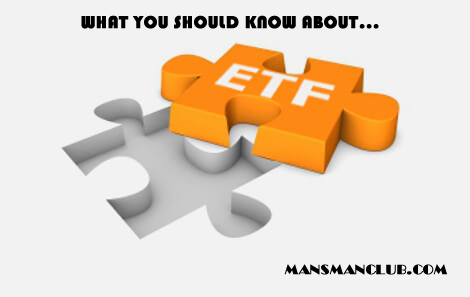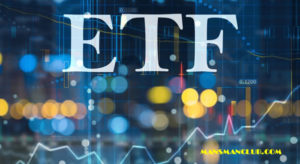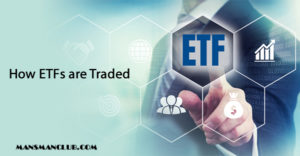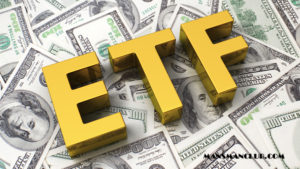Learn About ETFs (Exchange Traded Funds)
 This is the next part of an investor’s self-education. If you did not have the chance to read the articles about stocks and bonds, look here:
This is the next part of an investor’s self-education. If you did not have the chance to read the articles about stocks and bonds, look here:
HOW TO START STOCK TRADING
INVESTING: WHAT IS A COMMON STOCK?
PREFERRED STOCKS AND SENIOR SECURITIES. PART I.
SENIOR SECURITIES & CORPORATE BONDS. PART II.
This time, I want to skip the introduction to the Mutual Funds and rather discuss Exchange Traded Funds (ETFs) that represent a collection of securities (stocks, commodities, bonds, or a mixture of investment types) that tracks an underlying index and represent certain strategy or sector.
An ETF is a marketable security that has an associated price that allows it to be easily bought and sold in the open market. Let’s see why ETFs have gained popularity among investors.
- The main advantage of ETF over Mutual Fund (and this is a reason why I am discussing it now) is that ETF can be traded like a regular stock during a day. With mutual funds, you are buying or redeeming shares directly with the fund at the end-of-day net asset value (NAV), and you will find out about your transaction the next morning as it is not traded on an exchange. In short, ETF is a liquid investment and the share prices fluctuate all day as the ETF is bought and sold.
- Another advantage of ETFs is low expense ratios (the cost to operate and manage the fund) and fewer broker commissions than buying several stocks individually (an ETF can own hundreds of stocks across various industries, or isolated to one particular industry or sector). The cost of investing in ETFs continues to come down. Expense ratios have been lowered further, while Vanguard is waiving commissions on nearly 1,800 ETFs. As you understand, expense ratios reduce the return received, and studies have shown that ETFs with higher expense ratios underperform their peers in most cases. ETFs typically have low expenses since they track an index and are less time-intensive.
- If you want to target a single sector for your portfolio, the ETFs can offer an excellent way to buy several stocks related to a particular industry or sector while allowing only one transaction fee.
- Tax efficiency. ETFs typically do not distribute capital gains, so, your tax liability is not increased by owning ETFs. I discuss it below.
- Normally, the price of an ETF is very close to the average price of the underlying securities being held in its portfolio. This transparency makes ETFs a convenient and easy option for investors who want to minimize the possibility that the share price could trade at a substantial premium or discount to the net asset value (NAV) of the fund (as can happen in a closed-end fund).
- And, finally, because there are multiple assets within an ETF, they are a popular choice for Some ETFs offer only U.S. stocks, bonds, and commodities, while others include many international investments.
The bottom line: people want liquidity, diversification, and ease of use. So, instead of choosing a mutual fund, they’re coming to the exchanges and buying the ETF. With roughly $4 trillion in assets that have come from ETFs, and over 2,000 ETFs currently in the presence and still growing, there’s still a lot of opportunities out there.
Exchange-traded funds provide a low-cost and accessible way of investing in a wide variety of securities, including large-cap stocks, emerging market debt, precious metals, currencies, and even agricultural commodities.
The largest exchange-traded funds issuers are State Street Global Advisors, Barclays Global Investors, PowerShares, and Vanguard.
How ETFs are Traded
The supply of ETF shares is regulated through an instrument known as creation and redemption, which involves large specialized investors, called authorized participants. The process is quite complicated, so, I won’t discuss it in detail as it is out of our scope.
When an investor buys a position in an ETF, they are exchanging shares with other investors through an exchange, similar to stock trading. ETF managers accommodate investment inflows and outflows by creating or redeeming “creation units,” -- the baskets of assets that repeat the total of the ETF’s holdings.
The volume of transactions can be very high for high-profile ETFs but very low for less-known. I know that some investors avoid certain ETFs because of low trading volume, and I can understand them – with a low trading volume, the spread between asking price and offered price can be much wider than with a high volume. So, you wouldn’t want to buy the share at a higher price because the asking price is high and similarly selling lower because the offered price to buy is far away from asking.
However, they should not mix the volume with liquidity. With ETFs, trading volume and liquidity are two entirely different things. Unlike closed-end funds (CEFs) where the new shares cannot be created, ETF investments are open-ended.
This is an important distinction. Even without a change in the net asset value (NAV), a CEF can see an unexpected swing in the market price if there is a spike in trading volume. By contrast, a large number of buy or sell orders are unlikely to change the price of an ETF drastically, since new shares can always be created.
 Types of ETFs
Types of ETFs
There are various types of ETFs available to investors that can be used for income generation, speculation, price increases, and to hedge or somewhat offset risk in an investor's portfolio.
- Bond ETFs include government bonds, corporate bonds, and state and local bonds—called municipal bonds or, as many investors call them, munies.
- Industry ETFs track a particular industry or sector such as technology, financing, banking, or the oil and gas sector typically identified in the fund title. Assets are passively managed around an underlying index.
- Commodity ETFs invest in commodities including crude oil, agriculture, or metals like gold and silver. A commodity ETF is usually focused on either a single commodity or is focused on investments in futures contracts. Other commodity ETFs track the performance of a commodity index that includes many individual commodities.
- Currency ETFs invest in foreign currencies such as the Euro or Canadian dollar. They track the performance of a single currency in the foreign exchange market against the US dollar or a basket of currencies.
- Inverse ETFs attempt to earn gains from stock declines by shorting stocks. Shorting is selling a stock, expecting a decline in value, and repurchasing it at a lower price. They are constructed by using various derivatives to profit from a decline in the value of an underlying benchmark. Inverse ETFs are considered risky investments and can lead to losses quickly if investors bet wrong on the market's direction. Inverse ETFs held for more than one day can lead to losses not to mention higher fees versus traditional ETFs.
- ETNs – Exchange Traded Notes. This is a very special kind of ETF that is senior, unsecured debt security (bond) but trades like a stock and is backed by an issuer like a bank (like UBS, Barclays). Exchange-traded notes (ETNs) are similar to exchange-traded funds in that they trade on a stock exchange and track a benchmark index.
The return of an ETN is linked to a market index or other benchmark. An ETN promises to pay at maturity, the full value of the index, minus the management fee. Be aware that not every brokerage company allows trading ETNs, especially those that are highly leveraged (like 2x and 3x where, for every dollar invested, an investor has the potential to earn double or triple the return they would otherwise earn).
- Smart-Beta ETFs. It’s a blend of active and passive investing that is using a rule-based approach to choosing a stock from a particular index that only exhibits certain behavior or metrics such as earnings growth, the momentum of a stock (the extent a stock moves up or down) or profitability.
The most common types of smart-beta ETFs: Equally weighted (based on stock price and market capitalization with equally weighted factors and each holding), fundamentally weighted (selected and weighted by total earnings, profits, revenue, or financially driven fundamentals and metrics), factor-based: (selecting is based on specific factors such as balance sheet components, underpriced valuations, or smaller companies that are growing), low volatility (with low volatility or small price fluctuations over a historical period).
Recently, a new breed of ETF is being offered to investors. While the majority of ETFs are passively managed because they are mostly Indexed-Stock ETFs (offering the diversification of an index fund as well as the ability to sell short, and buy on margin), the actively-managed ETFs have portfolio managers who are more involved in buying and selling shares of companies and changing the holdings within the fund.
It is important that investors do due diligence on how the fund is managed, whether it's actively or passively managed, the resulting expense ratio, and weigh the costs versus the rate of return to make sure it is worth holding. Typically, an actively managed fund will have a higher expense ratio than passively-managed ETFs.
Taxes and Dividends
I need to mention the tax implications related to holding ETFs. An ETF is more tax-efficient than a mutual fund since most buying and selling occurs through an exchange and the ETF sponsor does not need to redeem shares each time an investor wishes to sell, or issue new shares each time an investor wishes to buy.
Redeeming shares of a fund can trigger a tax liability, so, listing the shares on an exchange can keep tax costs lower. In the case of a mutual fund, each time an investor sells their shares, they sell it back to the fund and incur a tax liability that must be paid by the shareholders of the fund.
Since many ETFs are holding the stocks that offer dividends, they extend the offer to investors, too. It provides you not only with the ability to gain as stock prices rise but also collect the monthly or quarterly dividends. Dividends are a portion of earnings allocated or paid by companies to investors for holding their stock.
How to Buy and Sell ETFs
ETFs can be traded like regular stocks through online brokers and traditional broker-dealers: Fidelity, E*Trade, Schwab, Interactive Brokers, or TDAmeritrade. An alternative to standard brokers are Robo-advisors like Betterment and Wealthfront who make use of ETFs in their investment products. I use several brokerage companies to trade stocks and ETFs.
Below are descriptions of some heavily-traded ETFs on the market.
- SPDR S&P 500 (SPY): The oldest ETF that tracks the S&P 500 Index. Average volume 71 million shares.
- iShares Russell 2000 (IWM): Tracks the Russell 2000 small-cap index. Average volume 19.4 million.
- Invesco QQQ (QQQ): Indexes the Nasdaq 100, which typically contains technology stocks. Average volume 33.8 million.
- Sector ETFs: Track individual industries such as oil (OIH), energy (XLE), financial services (XLF), REITs (IYR), Biotech (BBH), Consumer Staples (XLP), and Gold Miners ETF (GDX).
- Commodity ETFs: Represent commodity markets including crude oil (USO) with an average volume of 29 million.
- Physically-Backed ETFs: The SPDR Gold Shares (GLD) and iShares Silver Trust (SLV) hold physical gold and silver bullion in the fund
- Bond ETFs: (HYG) -High Yield Corporate Bond with an average volume of 19 million shares.
By the way, bond ETFs have experienced astonishing inflow lately -- over $83B.
How to Research ETFs
As it applies to stocks, you have to do your due diligence with ETF in a similar manner.
- Understand what the underlying index represents: Most ETFs follow an index, and holdings and percentage of holdings are very transparent.
- Understand the ETF’s structure: Some ETFs are securities-based, whereas others—such as commodities and currencies—represent futures or physically backed holdings.
- Know the costs: Some ETFs have expense ratios as low as four basis points (0.04%), while others can be 90 or 100 basis points.
- Don’t assume all ETFs are cost-effective. Look at the underlining selection of the stocks.
- Understand liquidity: ETFs trade like stocks and have bid/ask spreads. Tracking volume and the spread is easy but requires monitoring.
As with any other investments in my liquid portfolio, I use Google spreadsheet for research on ETFs. It allows comparing various ETFs or just monitoring the “Market Pulse” (as I have named it), where I include major ETFs. The prices are updated in real-time, the cells change the color depending on price, and the volume above 120% will be shown in a bright color to attract attention.
Normally, I look at the expense ratio, underlying securities, average volume, sector exposure, and the dividends (if any), in addition to studying the charts. I also hold several smart-beta ETFs in my Motif Portfolio that I will discuss it in future articles.
As for the online sources of information on ETFs, I use several websites (not counting several mobile applications):
www.stockcharts.com (Free to $39.95/mo.)
www.tradingview.com (Free to $39.95/mo.)
www.finviz.com (Free to $29.95/mo.)
http://www.morningstar.com/ (Free to $16.58/mo.)
https://www.etf.com/channels/bond-etfs (and several others categories)
Bottom line:
ETFs can help you build your portfolio simplifying the selection of the stocks not only for diversification or concentration in certain sectors but even for betting on the market’s direction and volatility.
For instance, you are very bullish on the positive market direction. You could buy the ProShares UltraPro Dow30 ETF (NYSE: UDOW), which should move roughly three times as much as the Dow Jones Industrial Average Index.
Want to bet against the China market? The Direxion Daily FTSE China Bear 3X Shares (NYSE: YANG) will trade inversely to the FTSE China 50 Index. So, if that index falls 5%, the ETF will rise 15%.
There are many ETFs for nearly any facet of the market that an investor would want to work with. Essentially, if you can come up with an investment idea, there is probably a way to trade it through an ETF.
The ETFs provide flexibility, liquidity, and a wide range of ideas, whether you are a long-term investor or a trader looking to participate in the move of a specific sector (up or down). ETFs are a great way to invest if you don’t want to own individual stocks.
What will follow next? I will discuss the CEFs (Closed-End Funds).
You may write your comments below.
If you are not a club member, simply fill out a short form below for free membership. You will get notifications about a new article.
DISCLAIMER: This article is intended to provide information to interested parties. As I have no knowledge of individual investor circumstances, goals, and/or portfolio concentration or diversification, readers are expected to complete their own due diligence before following any investment strategies or rules mentioned or recommended.
Author's Note: Please excuse any typos. I assure you that I will do my best to correct any errors if they were overlooked.


